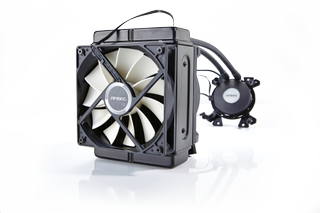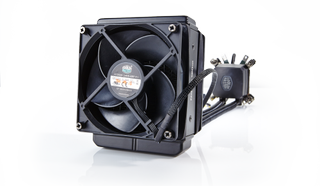Closed-loop liquid cooler roundup: 8 coolers reviewed

Antec Kuhler H20 950
Radiator size: 120mm
Radiator thickness: 49mm
Fans: 1x 120 PWM attached, 1x 120mm PWM
Motherboard connections: 1x 3-pin, 1x USB
Antec really do keep on trying with their Kuhler H20 range of liquid chip-chillers, but they sometimes miss the mark. There are actually no bad coolers in this test and the $76 Kuhler H20 950 (£56) does perform pretty well, but in straight cooling terms it’s probably the weakest of the lot.
I’m not particularly enamoured with the design of the Kuhler’s mounting mechanism either. The fact that one of the fans is permanently attached to the radiator, housing the actual pump, makes things slightly easier, but not by much. The big problem I had is that, while the universal bracket attached to the CPU contact plate makes it easy to switch between AMD and Intel motherboards, the four arms you screw onto the loose-fit backing plate shift positions at the slightest touch.
When you’re holding the backing plate on with one hand and trying to attach the CPU contact plate with the other you will discover the very essence of frustration. It doesn’t help that the bolts you screw the cooler into regularly shoot off the motherboard backing plate with little contact. That means you really need to remove the whole board from your chassis to stand any chance of fitting it on your own. That makes the process much smoother, but it's an extra step.
The Kuhler H20 950 is very, very quiet, even with the second push-me-pull-you fan attached to the fat 120mm radiator. Though unfortunately it doesn’t really cool that well at stock settings. In fact, it runs the hottest of all these coolers. Not dramatically, but it’s still bottom of the class. It does well in the peak-to-idle performance, especially at stock CPU speeds. Hitting the idle temperature in just seven seconds is outstanding. Unfortunately with the chip overclocked the Kuhler danced around the idle temperature for almost a minute and a half before settling down again.
The software, controlled via the USB connection, should help there, allowing you to adjust fan profiles and such, but it glitched out continually during testing. With the last Kuhlers I tested from Antec I had similar problems.The Kuhler H20 950 though the cheapest cooler here, which does put its weaker performance into some perspective.
Score: 81%
Verdict: Bottom of the class in peak temperatures, but a very good price for a not-bad water-cooler.
PC Gamer Newsletter
Sign up to get the best content of the week, and great gaming deals, as picked by the editors.

Cooler Master Nepton 120XL
Radiator size: 120mm
Radiator thickness: 38mm
Fans: 2x 120mm PWM
Motherboard connections: 2x 4-pin
If you want a lesson in the benefits of a 240mm radiator over a 120mm, you only have to look at the Nepton coolers in this test. With more surface area in the larger radiator, the same number of fans, running at the same speeds, are able to shift the heat out of the coolant liquid far quicker, returning your stressed CPU back to it’s idle temperatures much faster.
Cooler Master have tried to offset that by using a fatter radiator in the $90 Nepton 120XL (£69), and by arranging a pair of fans in a push-me-pull-you setup either side of it. While that means its peak temperature performance is pretty close to the impressive 240M, it is a little warmer. After around thirty seconds the CPU temperature was almost back to idle, but remained a good few degrees off for a long while. In the grand scheme of things that’s not a huge issue, but highlights the extra performance of the longer rads.
The 120XL shares the same excellent mounting setup as the other Nepton and is just as quiet in operation. I also like the flexibility in attaching it to your case, allowing you to mount the second fan outside the chassis, pinning the radiator in place through the standard 120mm chassis fan mount. If there’s limited space in your case, that’s a great help. If you’ve got space for the longer radiator however, the slight extra expense of the 240M is worth it.
Score: 75%
Verdict: The same great mounting setup as the Nepton 240M, but without the cooling power of the 240mm design.

Thermaltake Water 3.0 Pro
Radiator size: 120mm
Radiator thickness: 49mm
Fans: 2x 120mm PWM
Motherboard connections: 2x 4-pin
This smaller Thermaltake cooler comes with a rather chubby radiator. It may not be as long as its Ultimate brethren, but it’s almost twice as fat. And, in terms of actual cooling performance, that seems to help it get mighty close to the top coolers in this test. It’s actually one of the overall coolest of the lot and was pretty darned quick in its peak-to-idle performance too.
That all sounds rather positive, so why is it bringing up the rear in this month’s grouptest? Well, one of the reasons we opt for water-cooling is because it can lead to a quieter machine; the slower-spinning fans are meant to be quieter than an active air-cooler’s. The $85 Water 3.0 Pro (£85) gets pretty loud and blowy once you start cranking up the CPU load, regardless of whether the chip’s overclocked or not.
That would almost be forgivable had the pitch of the fans been slightly lower. There is a definite whiney quality about them which puts me in mind of a straining toy helicopter. So while the cooling performance is good it does come at a high, aural price. I’d much rather have my CPU running a couple of degrees hotter if I could keep the noise down. The Water 3.0 Pro then would force me into the murky world of BIOS-based fan-tweaks, somewhere I don’t want to be.
Score: 72%
Verdict: Very cool for a 120mm cooler, but louder than most of the other alternatives in this test.
| Cooler | 100% CPU turbo (3.9 GHz) | 100% CPU turbo (4.5GHz OC) | Peak-to-idle time (OC) |
|---|---|---|---|
| Cooler Master Nepton 240M | 53°C | 62°C | 15 seconds |
| Thermaltake Water 3.0 Ultimate | 50°C | 60°C | 13 seconds |
| Zalman Reserator 3 Max Dual | 50°C | 59°C | 32 seconds |
| Corsair H100i | 54°C | 66°C | 21 seconds |
| Antec Kuhler H20 950 | 57°C | 69°C | 84 seconds |
| Cooler Master Nepton 120XL | 55°C | 66°C | 172 seconds |
| Thermaltake Water 3.0 Pro | 50°C | 61°C | 46 seconds |

Dave has been gaming since the days of Zaxxon and Lady Bug on the Colecovision, and code books for the Commodore Vic 20 (Death Race 2000!). He built his first gaming PC at the tender age of 16, and finally finished bug-fixing the Cyrix-based system around a year later. When he dropped it out of the window. He first started writing for Official PlayStation Magazine and Xbox World many decades ago, then moved onto PC Format full-time, then PC Gamer, TechRadar, and T3 among others. Now he's back, writing about the nightmarish graphics card market, CPUs with more cores than sense, gaming laptops hotter than the sun, and SSDs more capacious than a Cybertruck.
Most Popular

